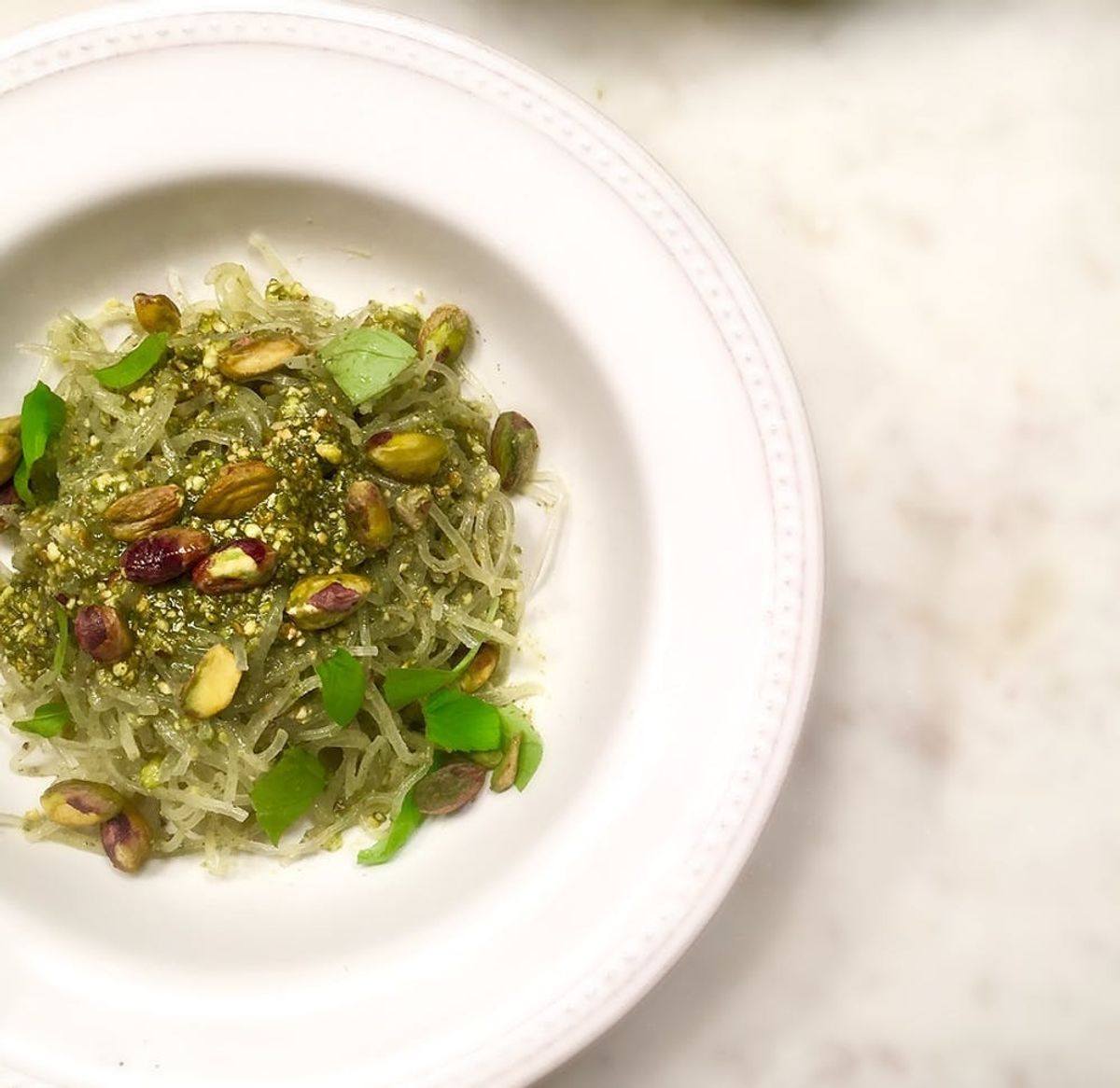The surprising skinny jeans food you’ll want to slip into your daily meals pronto.
The Surprising Skinny Jeans-Friendly Food You Haven’t Tried Yet

Drooling over the thought of pistachio pesto pasta? Join the club, ladies. What if we told you we had a killer recipe for kelp pistachio pesto pasta? It’s not just a visual stunner — keep scrolling — it’s a nutritionist’s dream. Richer in minerals than land vegetables, sea veggies like kelp also offer complex carbohydrates that stabilize blood sugar (Read: Enhance your energy!), a high concentration of amino acids that assist your belly in keeping digestion running smoothly and is a natural source of iodine. Whether you’re new to the sea veggies universe or already a pro at rolling your own sushi, it’s well worth familiarizing yourself with this potent nutrition powerhouse that, chances are, you probably aren’t eating regularly.

In fact, a recent study out of Newcastle University has even linked compounds in seaweed to supercharging weight loss efforts. We spoke with nutritionist Lisa Hayim, RD, with an M.S. in Nutrition and Exercise Physiology, for the top reasons to load up sea veggies and the most common kinds, so grab your favorite healthy snack and keep reading. Or, you know, keep drooling.
1. Sea vegetables are off the charts in terms of nutrition. “Compared to plants from the land, sea vegetables can contain as much as 10 to 20 times higher content of vitamins and minerals and also are an excellent source of vitamins A, D, E and B12,” says Hayim.
2. They leave you feeling fuller, longer. “Seaweed and seaweed isolates have been shown to have the potential to enhance feelings of satiety in humans. Because of this, they’re being added into our foods in efforts to help combat obesity.”
3. Eating them regularly can make up for skipping out on eating other nutritious foods. “Seaweed also has a mineral content higher than that in edible plants from the land and animal products. Sea vegetables are effective, even in relatively small amounts, in supplying our food with missing elements.”
4. It may slash your risk of disease. “East Asian populations such as Japan, Korea and China have had these foods regularly integrated into their diet since ancient times. The result is a diet very high in iodine, and an extremely low incidence of breast cancer.”
Now that you’ve got the basics on sea veggies’ incredible health benefits, you may be wondering what kinds are out there and what you can do with them. Behold: three of the most popular types and exactly how to DIY your way to deliciousness.

1. Nori: “Nori is a piece of dried red algae, most widely known for its use in sushi,” offers Hayim. “Nori may be beneficial for your glycemic index, which is the rise of blood sugar after a meal. Typically, diabetics want to aim for foods with a lower glycemic index, to avoid a surge in blood sugar after consumption. A fascinating study compared blood sugar peaks after consuming white bread (known to make blood glucose skyrocket), to eating white bread paired with nori. The results revealed that nori eaten with bread actually decreased the sharp glucose peaks that normally occur with white bread alone,” Hayim explains. “Another study, examining the microbiology of nori, found that the dried seaweed is the most excellent source of vitamin B12 [which your body needs to function] among the edible seaweeds, making it an excellent source for strict vegans/vegetarians since B12 is mainly provided by animal products,” she adds.
How-to: “Homemade sushi is a great way to get nori into your diet. When I’m in a rush, I simply place avocado inside a sheet of nori, roll it up, and dip it in low-sodium soy sauce or Bragg’s Amino acids. Sometimes, I just use raw strips of Nori as a low-calorie snack to munch on,” Hayim offers.

2. Kombu ($11 for 2.1-oz pack): “Kombu is a type of edible brown seaweed that is a good source of dietary fiber and antioxidants. In addition, it is a rich source of iodine, the essential mineral for normal thyroid function (which controls metabolism and weight),” explains Hayim. Kombu may also be helpful in reducing high blood pressure.
How-to: “I like to add kombu to broth, or use it in a soup to help tenderize the beans,” suggests Hayim. If you’re cooking beans from scratch, throw half a stick or so in with the water at the start to help enhance the digestibility of the beans and make them soak up some added flavor.

3. Kelp: “Sea kelp is a brown algae that grows on the bottom of the sea, and is especially rich in nutrients such as beta carotene, fiber, chlorophyll, protein enzymes and amino acids,” Hayim tells us.
How-to: “Kelp pasta (like the Kelp Pistachio Pesto Pasta pictured above) has no starch, and comes in at just six calories per serving, and 18 calories in the entire traditional package, making it the perfect low-calorie and nutrient-dense food to aid in weight loss,” says Hayim. Look for them in the Asian food aisle or at health food stores near you.
Got a favorite sea veggie dish? Share with us@BritandCo!
(Photos + recipes via The Wellnecessities)



















